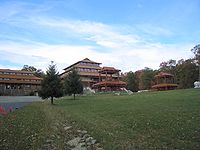
Chuang Yen Monastery
Encyclopedia

Pure land
A pure land, in Mahayana Buddhism, is the celestial realm or pure abode of a Buddha or Bodhisattva. The various traditions that focus on Pure Lands have been given the nomenclature Pure Land Buddhism. Pure lands are also evident in the literature and traditions of Taoism and Bön.The notion of 'pure...
buddhist
Buddhist monasticism
Monasticism is one of the most fundamental institutions of Buddhism. Monks and nuns are responsible for preserving and teaching Buddhist teachings and guiding Buddhist lay followers. Earlier Buddhist monks were enlightened...
monastery
Monastery
Monastery denotes the building, or complex of buildings, that houses a room reserved for prayer as well as the domestic quarters and workplace of monastics, whether monks or nuns, and whether living in community or alone .Monasteries may vary greatly in size – a small dwelling accommodating only...
in Carmel
Carmel, New York
Carmel is a town located in Putnam County, New York, USA. As of the 2000 census, the town had a total population of 36,465.There are no incorporated villages in the town, although the hamlets of Carmel and Mahopac each have populations sizable enough to be thought of as villages.The Town of Carmel...
, New York
New York
New York is a state in the Northeastern region of the United States. It is the nation's third most populous state. New York is bordered by New Jersey and Pennsylvania to the south, and by Connecticut, Massachusetts and Vermont to the east...
. The monastery was built and is maintained by the Buddhist Association of the United States on land donated by C. T. Shen. His autobiography, My Memoir is published by The Institute for Advanced Studies of World Religions and is distributed free at the monastery.
The monastery grounds contain several prayer halls, dormitories, a dining hall, a memorial area, and a library. Most of the buildings are built in an imitation of Tang dynasty
Tang Dynasty
The Tang Dynasty was an imperial dynasty of China preceded by the Sui Dynasty and followed by the Five Dynasties and Ten Kingdoms Period. It was founded by the Li family, who seized power during the decline and collapse of the Sui Empire...
architecture, and the main hall contains a 37-foot statue of the Buddha Vairocana
Vairocana
Vairocana is a celestial Buddha who is often interpreted as the Bliss Body of the historical Gautama Buddha; he can also be referred to as the dharmakaya Buddha and the great solar Buddha. In Sino-Japanese Buddhism, Vairocana is also seen as the embodiment of the Buddhist concept of shunyata or...
, encircled by 10,000 small statues of the Buddha on a lotus terrace. The larger Buddha statue is said to be the largest of its kind in the Western Hemisphere.
They hold also seminars and summer camps in both the English and Chinese languages.
Library
The monastery is home to more than one library collection.Reportedly, the Woo Ju Memorial Library has a collection of "2,500 books in Chinese, [and] 1,000 books in English", --not mentioning collections in Sanskrit
Sanskrit
Sanskrit , is a historical Indo-Aryan language and the primary liturgical language of Hinduism, Jainism and Buddhism.Buddhism: besides Pali, see Buddhist Hybrid Sanskrit Today, it is listed as one of the 22 scheduled languages of India and is an official language of the state of Uttarakhand...
, Pali
Páli
- External links :* *...
, Tibetan
Standard Tibetan
Standard Tibetan is the most widely used spoken form of the Tibetan languages. It is based on the speech of Lhasa, an Ü-Tsang dialect belonging to the Central Tibetan languages. For this reason, Standard Tibetan is often called Central Tibetan...
, or other languages. Some websites report the size of the collection at 73,764 books. Until 2006, the library was home to the collections and offices of the Institute for Advanced Studies of World Religions--but it is unclear if this now operates out of its offices in New York City, or has ceased to exist, as its collections were reportedly donated to the University of Virginia
University of Virginia
The University of Virginia is a public research university located in Charlottesville, Virginia, United States, founded by Thomas Jefferson...
in (ca.) 2006. At present (2009), the website for the Institute is blank or empty.
The library is named after the wife of C.T. Shen.

